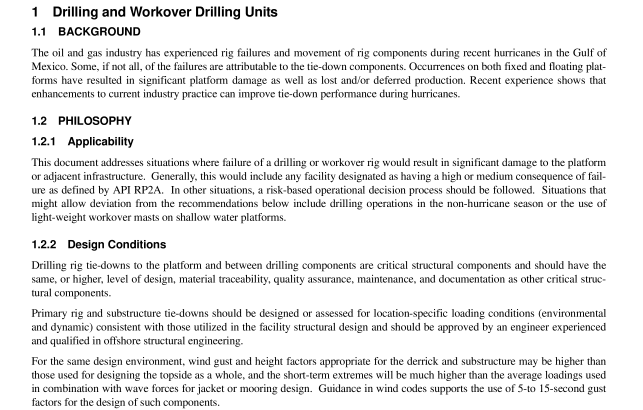API Bull 2TD:2006 pdf free download.Guidelines for Tie-downs on Offshore Production Facilities for Hurricane Season
1.1 BACKGROUND The oil and gas industry has experienced rig failures and movement of rig components during recent hurricanes in the Gulf of Mexico. Some, if not all, of the failures are attributable to the tie-down components. Occurrences on both fixed and floating plat- forms have resulted in significant platform damage as well as lost and/or deferred production. Recent experience shows that enhancements to current industry practice can improve tie-down performance during hurricanes.
1.2 PHILOSOPHY
1.2.1 Applicability This document addresses situations where failure of a drilling or workover rig would result in significant damage to the platform or adjacent infrastructure. Generally, this would include any facility designated as having a high or medium consequence of fail- ure as defined by API RP2A. In other situations, a risk-based operational decision process should be followed. Situations that might allow deviation from the recommendations below include drilling operations in the non-hurricane season or the use of light-weight workover masts on shallow water platforms.
1.2.2 Design Conditions Drilling rig tie-downs to the platform and between drilling components are critical structural components and should have the same, or higher, level of design, material traceability, quality assurance, maintenance, and documentation as other critical structural components. Primary rig and substructure tie-downs should be designed or assessed for locationspecific loading conditions (environmental and dynamic) consistent with those utilized in the facility structural design and should be approved by an engineer experienced and qualified in offshore structural engineering.
For the same design environment, wind gust and height factors appropriate for the derrick and substructure may be higher than those used for designing the topside as a whole, and the short-term extremes will be much higher than the average loadings used in combination with wave forces for jacket or mooring design. Guidance in wind codes supports the use of 5-to 15-second gust factors for the design of such components.
Dynamic accelerations and tilting of the platform topside should also be considered, again at the extreme (not RMS) level. Rigid body (quasi-static) analysis of the rig packages themselves may be used as a first approximation.
1.3 SHORT-TERM RECOMMENDATIONS The following items should be considered for implementation as appropriate by the platform operator and/or rig owner in the short-term timeframe:
• Visually inspect all tie-downs to confirm that they are in good condition and are constructed per the design drawings.
• Verify that all tie-downs can be properly installed and that no obstructions exist that might prevent installation (e.g. stiffen-
ers on plate girders).
• For bolted tie-downs:
– Verify by visual inspection that the bolts are in good physical condition.
– Verify that bolts meet the required material specifications and the specifications are suitable for this application.
Note: ASTM 325 or 490 high strength bolts are not recommended, since retorquing of these bolts is not permitted per AISC specifications.
– Verify that the number of bolt torquing cycles does not exceed the design allowable.
– Verify required bolt torque is defined and required equipment/tools are available to achieve the required torque.
– New bolts should be installed if the above items cannot be verified.
• For mechanical/hydraulic tie-downs:
– Verify that the tie-down system is in good working condition.
– Verify that operating personnel are familiar with the operating procedures of the equipment.
– Verify that equipment is fail safe (tie-down force will be maintained in the event of equipment failure).
• For welded tie-downs:
– Verify that plans, weld size, welding procedures, and inspection procedures are adequate.
• Verify that welded components of tie-downs have been properly inspected.
• Determine if there is a preferred well position for stowing the rig. If so, verify that this is clearly defined in the platform hurricane evacuation procedures.
• Verify that proper tie-down procedures are part of the platform evacuation procedures and that proper tie-down is verified in writing by the Offshore Installation Manager (OIM) or his designate prior to evacuation.
• Verify that other procedures such as setting down of all drill pipe, handling of setback load, emptying of tanks, etc. are clearly defined in the evacuation procedures and have been considered in engineering of the tie-down procedures.
• Verify that all required tie-down tools, equipment, and labor including all required spares will be available as required prior to evacuation. Any new components should be prefabricated for quickness and ease of connection.
• Verify that hurricane evacuation procedures allow time for proper tie-down prior to evacuation.API Bull 2TD pdf download.API Bull 2TD:2006 pdf free download
